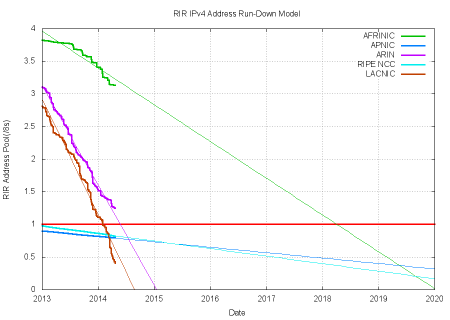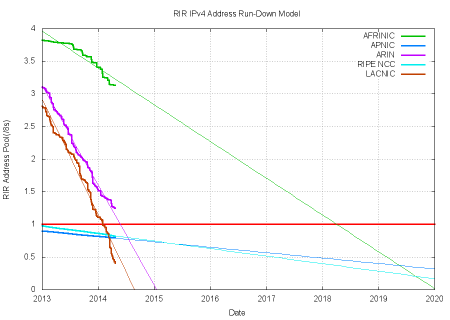Regional Internet Registries (RIRs) have been running out of IPv4 addresses to give to organizations that operate in their respective geographies. Early on the run-out was difficult to predict because policies were still in flux. However, in recent years, with the soft-landing policies each RIR adopted the recent address run-out has been slow but steady.
There have been many address exhaustion predictive models, but the one that has been kept current and seems to be the most accurate is the one created by Geoff Huston. Following is his recent address exhaustion prediction graph.
Stages of IPv4 Address Exhaustion
As each of these RIRs has been reaching their final IPv4 blocks of addresses, they have been using soft-landing policies to gracefully run-out. Each RIR has had their own policies and their own definitions for how they are managing the final blocks of their address space. Now, these RIRs are going to have to aggressively conserve their final address blocks.
IANA – The Internet Assigned Number Authority (IANA) allocated addresses to the RIRs operating around the world. On February 3, 2011 they allocated the last of the /8 blocks to the RIRs. From that point on, it was up to the RIRs to manage their finite resource.
APNIC IPv4 Address Exhaustion – The APNIC RIR reached their final /8 equivalent amount of available IPv4 addresses on April 15, 2011. At that point they moved from Stage 2 exhaustion to Stage 3.
RIPE NCC IPv4 Address Exhaustion – RIPE NCC reached their final /8 equivalent on September 14, 2012. Since then, like APNIC, they have only been allocating /22 blocks to Local Internet Registries (LIRs) on an emergency basis.
LACNIC IPv4 Address Exhaustion – The LACNIC has also been managing their final addresses. However, their economies are growing and more members of their communities are getting connected to the Internet driving addressing pressure. This page states the LACNIC IPv4 address depletion phases.
AFRINIC IPv4 Address Exhaustion – The Africa region has been increasing their Internet connectivity over the years. More and more people are getting connected to the Internet and that means that more people in that region need IPv4 addresses. However, the AFRINIC RIR has a slower address consumption rate of other RIRs and they are not likely to run out for many years.
ARIN IPv4 Address Exhaustion – Today, the American Registry for Internet Numbers (ARIN) has announced that they have reached their final /8 equivalent amount of IPv4 addresses. At this point, ARIN will now move into Phase 4 of their IPv4 countdown plan. Now, IPv4 addresses are only allocated on an “emergency” basis and it will be extremely difficult to justify that your organization represents and Internet emergency. Based on ARIN’s Number Resource Policy Manual (NRPM), organizations may only qualify to receive a single /22 if their emergency request is approved. As people have said before, if it is so difficult to get your address request granted, we have effectively run out of addresses. This is a difficult situation because most organizations have no plans to stop using IPv4 in the next 20 years.
Address Transfer Market
If your RIR has reached exhaustion and you are not a LIR or service provider and you are an enterprise organization, then the only way for you to get IPv4 addresses in the future is to buy them. Your organization will need to work out an arrangement with an organization that has IPv4 addresses for sale. You can negotiate whatever price the current market dictates. Then you can perform an address transfer with your RIR to keep the records updated. If you are interested in how this works in the ARIN region, here is a link to their transfer policies.
The concern here is that over time the price of IPv4 addresses will increase as they become increasingly scarce. Currently, the price of an IPv4 address is between $15 and $30, however, these prices can quickly reach $100 or more per address. A /24 could end up costing your organization $25,000.
Is It Too Late for IPv6 Planning?
The Internet community has been anticipating that the exhaustion of IPv4 addresses would help drive interest in IPv6. All organizations need to consider if they have enough IPv4 addresses to sustain their businesses indefinitely.
It is human nature to put off the inevitable until the last minute. For example, people seem to like driving in the fast-lane of the freeway and then just start planning to exit the highway just as they pass their exit. Some people put off buying a new toothbrush until their brush only has a few bristles remaining.
Now it is beyond the point where organizations should start to plan for IPv6. In other words, the airplane has run out of gas and the engines are stopped so you had better start to think about packing your parachute. The truth is, your organization should have been planning for IPv6 years ago. If your organization just started to contemplate IPv6, you will likely be struggling for the next couple of years to get IPv6 implemented.
If your organization has procrastinated and hasn’t started planning for IPv6, there is no time like the present. You are encouraged to use an IPv6 address planning utility and determine how much IPv6 address space you may need. Then hurry up and make your request for IPv6 addresses from your RIR. At that point, you can start to implement IPv6 at your Internet perimeter and then start to gradually bring the deployment into your organization.
This post originally appeared on the Infoblox blog at https://community.infoblox.com/blogs/2014/04/23/arin-runs-out-ipv4-addresses.

